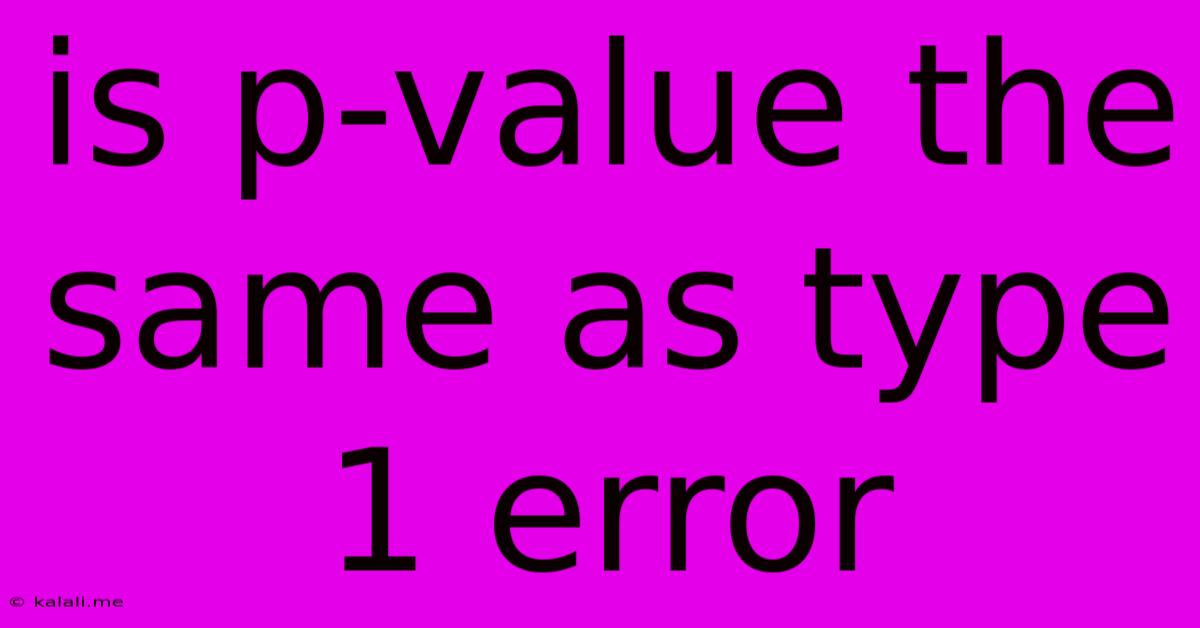Is P-value The Same As Type 1 Error
Kalali
May 24, 2025 · 4 min read

Table of Contents
Is P-Value the Same as Type I Error? A Clear Explanation
Meta Description: Understanding the relationship between p-value and Type I error is crucial in statistical analysis. This article clarifies the distinction, explaining how they're related but not interchangeable. Learn to interpret p-values correctly and avoid common misinterpretations.
Many students and researchers struggle to differentiate between a p-value and a Type I error. While closely related, they are distinct concepts in statistical hypothesis testing. This article will clarify the difference, helping you understand their individual roles and avoid common misconceptions.
What is a P-Value?
The p-value is the probability of obtaining results as extreme as, or more extreme than, the observed results, assuming the null hypothesis is true. In simpler terms, it quantifies the evidence against the null hypothesis. A small p-value (typically less than 0.05) suggests strong evidence against the null hypothesis, leading researchers to reject it in favor of the alternative hypothesis. However, it's crucial to remember that a small p-value doesn't automatically prove the alternative hypothesis is true; it simply indicates that the observed data are unlikely under the assumption of the null hypothesis.
Factors influencing the p-value include:
- Sample size: Larger sample sizes generally lead to smaller p-values, even with small effects.
- Effect size: Larger effects tend to produce smaller p-values.
- Variability: Higher variability in the data can result in larger p-values.
What is a Type I Error?
A Type I error, also known as a false positive, occurs when you reject the null hypothesis when it is actually true. In essence, you conclude there's a significant effect when, in reality, there isn't. The probability of committing a Type I error is denoted by alpha (α), which is usually set at 0.05 (5%). This means there's a 5% chance of rejecting a true null hypothesis.
The Relationship Between P-Value and Type I Error
The p-value and Type I error are linked through the significance level (alpha). The significance level (α) sets the threshold for rejecting the null hypothesis. If the p-value is less than or equal to α, we reject the null hypothesis. If the p-value is greater than α, we fail to reject the null hypothesis.
Therefore, a small p-value increases the risk of committing a Type I error. However, it's important to note that the p-value itself is not the probability of a Type I error. The probability of a Type I error is predetermined by the significance level (α).
Key Differences: P-Value vs. Type I Error
| Feature | P-Value | Type I Error |
|---|---|---|
| Definition | Probability of observing data as extreme as, or more extreme than, the observed data, assuming the null hypothesis is true. | Rejecting a true null hypothesis. |
| Nature | A calculated probability based on the data. | A potential outcome of a hypothesis test. |
| Value | A numerical value between 0 and 1. | A probability, typically set at 0.05 (5%). |
| Interpretation | Measures the strength of evidence against the null hypothesis. | Represents the risk of making a false positive conclusion. |
Avoiding Misinterpretations
A common misinterpretation is equating a p-value of 0.05 with a 5% chance of the null hypothesis being true. This is incorrect. The p-value only tells us the probability of observing the data given the null hypothesis is true, not the probability of the null hypothesis being true given the data. Bayesian methods offer a more direct approach to estimating the probability of the null hypothesis.
Another crucial point is that statistical significance (a low p-value) doesn't necessarily equate to practical significance. A small p-value might be obtained with a very small effect size, which may be irrelevant in a real-world context. Always consider the effect size alongside the p-value when interpreting results.
In conclusion, while the p-value and Type I error are related concepts in hypothesis testing, they are not interchangeable. Understanding this distinction is crucial for accurately interpreting statistical results and avoiding misleading conclusions. Remember to consider the context, effect size, and the limitations of p-values when making decisions based on statistical analysis.
Latest Posts
Latest Posts
-
How Many Sides To A Circle
May 24, 2025
-
Blender Weight Paint Symmetry Keeps Turning On
May 24, 2025
-
Error Stat Of Sqlnet Log Failed Permission Denied
May 24, 2025
-
Great Minds Think Alike In Spanish
May 24, 2025
-
Water From Faucet Smells Like Sulfur
May 24, 2025
Related Post
Thank you for visiting our website which covers about Is P-value The Same As Type 1 Error . We hope the information provided has been useful to you. Feel free to contact us if you have any questions or need further assistance. See you next time and don't miss to bookmark.